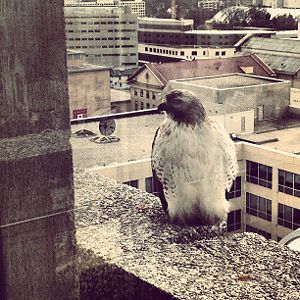Geometry and Topology Seminar 2019-2020: Difference between revisions
| Line 32: | Line 32: | ||
== Spring 2016 == | == Spring 2016 == | ||
[[Geometry and Topology Seminar Spring 2016]] | |||
<br><br> | <br><br> | ||
Revision as of 13:56, 29 October 2015
The Geometry and Topology seminar meets in room 901 of Van Vleck Hall on Fridays from 1:20pm - 2:10pm.
For more information, contact Tullia Dymarz or Alexandra Kjuchukova.
Spring 2016
Geometry and Topology Seminar Spring 2016
Fall 2015
Fall Abstracts
Hung Tran
Relative divergence, subgroup distortion, and geodesic divergence
In my presentation, I introduce three new invariants for pairs $(G;H)$ consisting of a finitely generated group $G$ and a subgroup $H$. The first invariant is the upper relative divergence which generalizes Gersten's notion of divergence. The second invariant is the lower relative divergence which generalizes a definition of Cooper-Mihalik. The third invariant is the lower subgroup distortion which parallels the standard notion of subgroup distortion. We examine the relative divergence (both upper and lower) of a group with respect to a normal subgroup or a cyclic subgroup. We also explore relative divergence of $CAT(0)$ groups and relatively hyperbolic groups with respect to various subgroups to better understand geometric properties of these groups. We answer the question of Behrstock and Drutu about the existence of Morse geodesics in $CAT(0)$ spaces with divergence function strictly greater than $r^n$ and strictly less than $r^{n+1}$, where $n$ is an integer greater than $1$. More precisely, we show that for each real number $s>2$, there is a $CAT(0)$ space $X$ with a proper and cocompact action of some finitely generated group such that $X$ contains a Morse bi-infinite geodesic with the divergence equivalent to $r^s$.
Tullia Dymarz
Non-rectifiable Delone sets in amenable groups
In 1998 Burago-Kleiner and McMullen constructed the first examples of coarsely dense and uniformly discrete subsets of R^n that are not biLipschitz equivalent to the standard lattice Z^n. Similarly we find subsets inside the three dimensional solvable Lie group SOL that are not bilipschitz to any lattice in SOL. The techniques involve combining ideas from Burago-Kleiner with quasi-isometric rigidity results from geometric group theory.
Jesse Wolfson
Counting Problems and Homological Stability
In 1969, Arnold showed that the i^{th} homology of the space of un-ordered configurations of n points in the plane becomes independent of n for n>>i. A decade later, Segal extended Arnold's method to show that the i^{th} homology of the space of degree n holomorphic maps from \mathbb{P}^1 to itself also becomes independent of n for large n, and, moreover, that both sequences of spaces have the same limiting homology. We explain how, using Weil's number field/function field dictionary, one might have predicted this topological coincidence from easily verifiable statements about specific counting problems. We then discuss ongoing joint work with Benson Farb and Melanie Wood in which we use other counting problems to predict and discover new instances of homological stability in the topology of complex manifolds.
Matthew Cordes
Morse boundaries of geodesic metric spaces
I will introduce a new type of boundary for proper geodesic spaces, called the Morse boundary, that is constructed with equivalence classes of geodesic rays that identify the ``hyperbolic directions" in that space. (A ray is Morse if quasi-geodesics with endpoints on the ray stay bounded distance from the ray.) This boundary is a quasi-isometry invariant and a visibility space. In the case of a proper CAT(0) space the Morse boundary generalizes the contracting boundary of Charney and Sultan and in the case of a proper Gromov hyperbolic space this boundary is the Gromov boundary. Time permitting I will also discuss some results on Morse boundary of the mapping class group and briefly describe joint work with David Hume developing a capacity dimension for the Morse boundary.
Anton Izosimov
TBA
Jacob Bernstein
Hypersurfaces of low entropy
The entropy is a quantity introduced by Colding and Minicozzi and may be thought of as a rough measure of the geometric complexity of a hypersurface of Euclidean space. It is closely related to the mean curvature flow. On the one hand, the entropy controls the dynamics of the flow. On the other hand, the mean curvature flow may be used to study the entropy. In this talk I will survey some recent results with Lu Wang that show that hypersurfaces of low entropy really are simple.
Yun Su
Higher-order degrees of hypersurface complements.
Gao Chen
Classification of gravitational instantons
A gravitational instanton is a noncompact complete hyperkahler manifold of real dimension 4 with faster than quadratic curvature decay. In this talk, I will discuss the recent work towards the classification of gravitational instantons. This is a joint work with X. X. Chen.
Dan Cristofaro-Gardiner
Higher-dimensional symplectic embeddings and the Fibonacci staircase
McDuff and Schlenk determined when a four dimensional symplectic ellipsoid can be embedded into a ball, and found that when the ellipsoid is close to round, the answer is given by an infinite staircase determined by the odd-index Fibonacci numbers. I will explain joint work with Richard Hind, showing that a generalization of this holds in all even dimensions.
Danny Ruberman
Configurations of embedded spheres
Configurations of lines in the plane have been studied since antiquity. In recent years, combinatorial methods have been used to decide if a specified incidence relation between certain objects ("lines") and other objects ("points") can be realized by actual points and lines in a projective plane over a field. For the real and complex fields, one can weaken the condition to look for topologically embedded lines (circles in the real case, spheres in the complex case) that meet according to a specified incidence relation. I will explain some joint work with Laura Starkston (Stanford) giving new topological restrictions on the realization of configurations of spheres in the complex projective plane.
Archive of past Geometry seminars
2014-2015: Geometry_and_Topology_Seminar_2014-2015
2013-2014: Geometry_and_Topology_Seminar_2013-2014
2012-2013: Geometry_and_Topology_Seminar_2012-2013
2011-2012: Geometry_and_Topology_Seminar_2011-2012
2010: Fall-2010-Geometry-Topology
